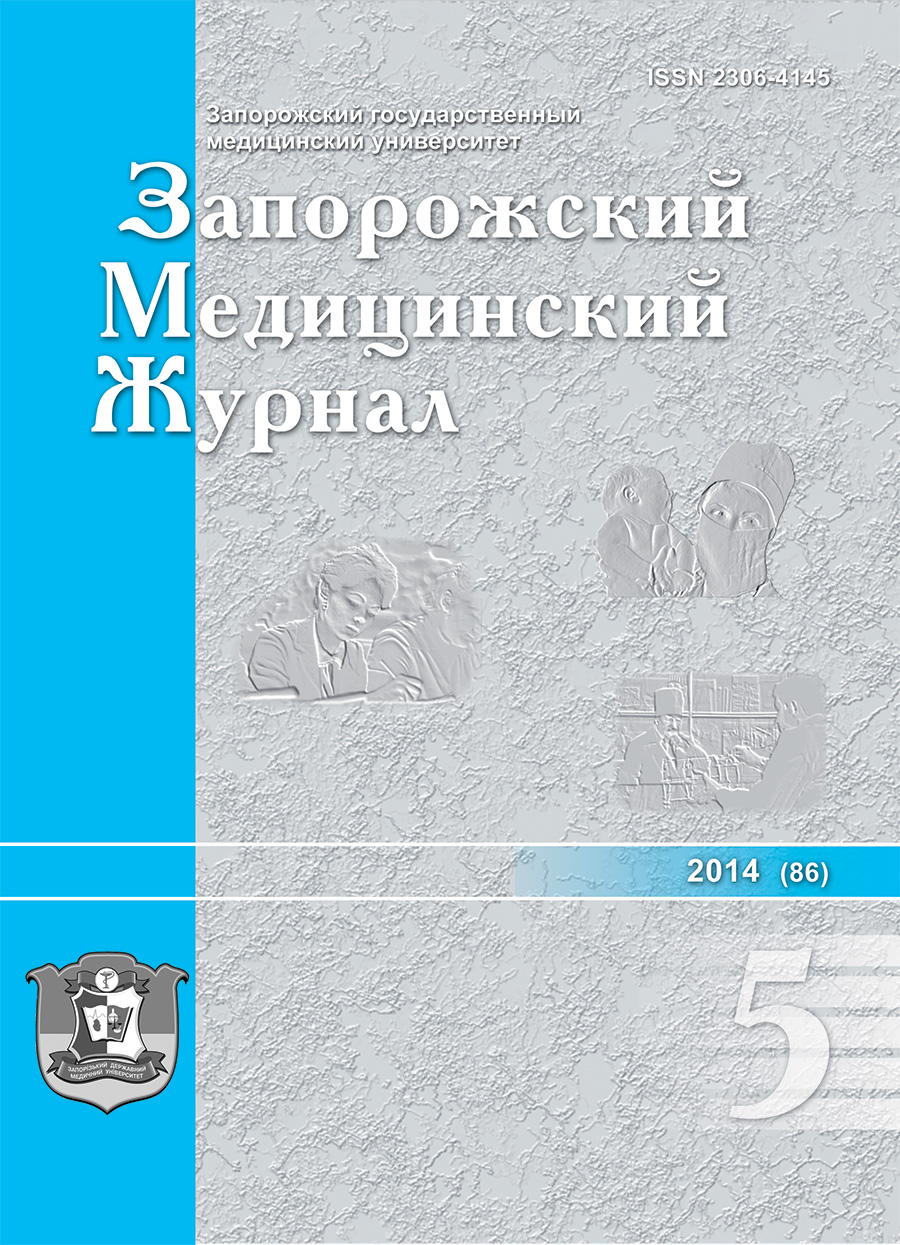Diagnostic value of AATs to β1- AR in elderly patients with chronic heart failure
DOI:
https://doi.org/10.14739/2310-1210.2014.5.28743Keywords:
Autoantibodies, Chronic Heart Failure, Adrenergic Receptor, Chronic Heart DiseaseAbstract
Aim. To study the deterioration of myocardial contractility in ischemic heart diseases.
Methods and results. We have examined 98 patients aged 69.5±7.9 years, including 65 people with coronary heart disease: stable tension angina EFII-III,CH IIA-IIB degree and 33patients without heart failure with preserved left ventricular ejection fraction (EF> 45%). At the initial stage all patients underwent VLP registration, echocardiography, and also testing the level of cardiotropic AABs using ELISA immunoassay. The levels of AABs to β1-AR, Com-02, Cos-05, L-myosin. Thus, in the group with elevated systolic myocardial dysfunction a high AAB titer to β1-AR was detected in 68.5% of patients, while in the group with normal left ventricular ejection fraction, only in 34.2%.
Conclusions. Thus, the obtained data suggest that the deterioration of myocardial contractility in ischemic heart diseases is associated with an increased titer of β1-AR.
References
Belenkov, Yu. N., Ageev, F. T., et al. (1999). E`pidemiologiya i prognoz khronicheskoj serdechnoj nedostatochnosti [Epidemiology and prognosis of chronic heart failure]. Russkij medicinskij zhurnal, 2, 51–56. [in Russian].
Poletaev, F. B. (2010). Fiziologicheskaya immunologiya (estestvennye autoantitela i problemy nanomediciny) [Physiological immunology (natural autoantibodies and problems of nanomedicine)]. Moscow: Miklosh. [in Russian].
Poletaev, F. B. (2008). Immunofiziologiya, immunopatologiya (izbrannye glavy) [Immunopathology (select heads)]. Moscow: Medicinskoe informacionnoe agenstvo. [in Russian].
Smyrnov, V. V., Petryaikina, E. E., Makusheva, V. G., &Poletaev, A. B. (2006) Soderzhanie estestvennykh autoantitel razlichnoj specifichnosti u detej, bol'nykh sakharnym diabetom [Table of contents of natural autoantibodies of different specificity for children patient with a diabetes mellitus]. Pediatrija, 4, 15–17. [in Russian].
Shumakov, V. I., Rulevaya, N. Yu., Korobov, N. V., Kazakov, E. N., Kormer, A. Ya., Nazarenko, P. V., et al. (1999). Razrabotka analiticheskogo metoda na osnovanii immunofermentnogo analiza dlya opredeleniya autoantitel k β1-adrenoreceptoram v syrovatke krovi bol'nykh s dilyatacionnnoj kardiomiopatiej [Developing an analytical method based on enzyme immunoassa for determing autoantibodies against b1-adrenoreceptors in blood serum of patients with dilation cardiomyopathy]. Vestnik transplantologii i iskusstvennyh organov, 4, 34–44. [in Russian].
Bristow, M. R. (2000). What type of beta-blocker should be used to treat chronic heart failure? Cirkulation, 102(5), 484–486. doi: 10.1161/01.CIR.102.5.484.
Caforio, A. L. P., Tona, F., & Bottaro, S. (2008). Clinical implications of anti – heart autoantibodies in myocarditis and dilated cardiomyopathy. Autoimmunity, 41(1), 35–45. doi: 10.1080/08916930701619235.
Caforio, A. L. P., Manton, N. G., Baig, M. K., et al. (2007). Prospective familial assessment in dilated cardiomyopaty: Cardiac autoantibodies predict disease development in asymptomatic relatives. Circulation, 115, 76–83. doi: 10.1161/CIRCULATIONAHA.106.641472.
Ceconi, C., Curello, S., & Ferrari, R. (1998). Catecholamines: the cardiovascular and neuroendocrine system. Eur.Heart. J, 19, 26.
Fredman, N. J., & Lefkowits, R. J. (2004). Anti-β1-adrenergic receptors antibodies and heart failure: causation, not just correlation. J. Clin. Invest, 113, 1379–1382. doi: 10.1172/JCI200421748.
Jahns, R., Boivin, V., Hein, L., Triebel, S., Angermann, C. E., Ertl, G., et al. (2004). Direct evidence for a β1-adrenergic receptor-directed autoimmune attack as a cause of idiopathic dilated cardiomyopathy. Journal of Clinical Investigation, 113(10), 1419–1429. doi: 10.1172/JCI200420149.
Kallwellis-Opara, A., Dorner, A., Poller, W. C., et al. (2007). Autoimmunological features in inflammatory cardiomyopathy. Clin Res Cardiol, 96(7), 469–480.
Lohse, M. J., Engelhhardt, S, & Eschenhagen, T. (2003). What ist role of β-adrenergic signaling in heart failure? Circ Res, 93, 896–906. doi: 10.1161/01.RES.0000102042.83024.CA.
Meroni, P. L., De Angeles, V., & Tedesko, F. (2007) Future trends. Autoantibodies Y. Shoenfeld, M.E. Gershwin, P.L. Meroni (Eds). Amsterdam: Elsevier, (p. 823–826).
Moss, A., & Stern, S. (1997) Noninvasive electrocardiology. Clinical aspects of Holter monitoring. Cambridge: University Press.
Notkins, A. L. (2007). New predictors of disease. J. Scientific American, 296, 54–62.
Portig, I., Sandomoeller, A., Kreilinger, S., & Maisch, B. (2009). HLA-DQBI* polymorphism and associations with dilaited cardiomyopathy inflammatory dilated cardiomyopathy and myocarditis. Autoimmunity, 42(1), 33–40. doi: 10.1080/08916930802258651.
Quintana, F. J., Getz, G., Hed, G., et al. (2003) Cluster analysis of human autoantibody reactivities in health and type I diabetes mellitus: a bio-informatics approach to immune complexity. J Autoimmun, 21(1), 65–75. doi: 10.1016/S0896-8411(03)00064-7.
Staudt, A., Bohm, M., Knebel, F. et al. (2009). Potencial role of autoantibodies belonging to the immunoglobulin G-3 subclass in cardiac dysfunction among patients with dilaited cardiomyopathy. Circulation, 106(19), 2448–2453.
Tomaszewski, M., Brain, N., Charchar, F. J.,Wang, W. Y., Laska, B., Padmanabahn, S., et al. (2002). Essential hypertension and β2-adrenergic receptors gene. Hypertension, 40, 286–291. doi: 10.1161/01.HYP.0000029105.21202.FE.
Downloads
How to Cite
Issue
Section
License
Authors who publish with this journal agree to the following terms:
Authors retain copyright and grant the journal right of first publication with the work simultaneously licensed under a Creative Commons Attribution License that allows others to share the work with an acknowledgement of the work's authorship and initial publication in this journal. 

